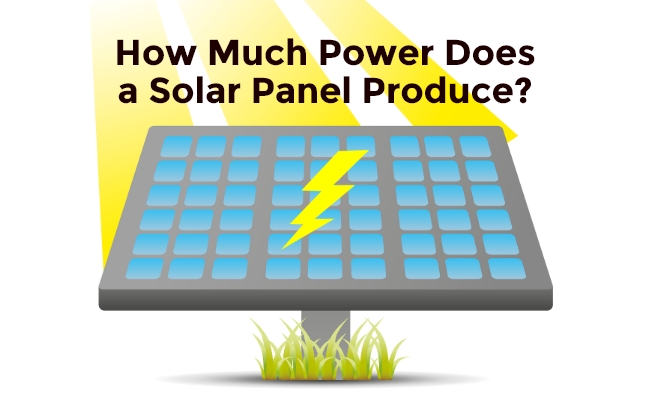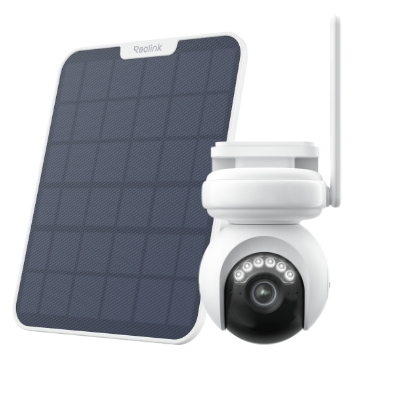How Much Power Does a Solar Panel Produce? Key Factors and Insights

Solar panels can be a relaxing addition to your house, granting freedom and independence to the household from the traditional grid system.
However, to reap maximum benefits, it is essential to know crucial information, such as how much energy a solar panel produces and how to measure it. So, keep reading; the forthcoming content will delve into all such information for your help.
Reolink New Year Sale - Save Big with Exclusive Deals!
Save big with Reolink! New Year Sale up to 45% off on security cameras, doorbells, and systems — Dec. 8 to Jan. 4.
How Is Solar Panel Output Measured?
You need to measure the solar panel's output to determine its capacity for electricity production. The primary unit used to measure solar panel output is wattage.
The solar panel wattage indicates the total power they can produce under ideal conditions. It is typically given in watts (W). It represents the peak power panel, which, when exposed to the full sunlight at 25 degrees under 1000 watts per square meter of solar irradiance.
Example: A panel with ratings of 400 watts can produce up to 400 watts of power under ideal conditions. However, the actual performance can vary on multiple factors like sunlight exposure and temperature.
How Much Power Does a Solar Panel Produce?
The power output of a solar panel is directly related to its wattage rating. Here is how you can determine how many kWh a solar panel produces.
To estimate the monthly and yearly production, multiply the daily kWh by the number of days a month for a year. For instance:
Monthly production = 2kWh/ day x 30 days = 60 kWh.
Similarly, the annual energy production = 2kWh/ day x 365 days = 730 kWh.
Average Solar Panel Output Per Day by Type
The power output of different solar panels is discussed as follows:
- Monocrystalline: Produces between 250 to 400 watts and is considered a highly efficient option.
- Polycrystalline: These have bluish hues and produce between 200 to 300 watts of energy per panel.
- Thin-Film: These panels are famous for being lightweight and flexible. They can produce between 100 to 200 watts per panel.
Solar panels can also power battery-operated security cameras. For example, the new Reolink Altas PT Ultra works seamlessly with the Reolink Solar Panel to provide continuous power.
Industry-leading 4K Continuous Recording Battery Camera
4K UHD Continuous Recording; ColorX Night Vision; Pan & Tilt; Automatic Tracking; All Recordings Stored Locally.
How to Calculate Solar Panel Energy Output
To determine how many watts a solar panel produces, you can use the following formulas:
Daily energy output (kWh) = Panel Wattage x Sunlight Hours/ 1000.
For example, if the panel is rated 400 watts and gets 5 hours of sun exposure, its daily output can be 400 watts x 5 hours/ 1000= 2kWh. Similarly, the formulas for money and annual energy output are:
- Annually Energy Output = daily energy output x 365.
- Monthly Energy Output = daily energy output x number of days in the month.
What Affects Solar Panel Electricity Generation
Solar panels are an exceptional source of energy production. However, multiple factors influence their ability to produce energy. Below, we have discussed some significant factors affecting solar panel performance and outcome.
Type of Panels
What type of panel you select highly influences the electricity outcome. Different types of solar panels are available in the market, such as polycrystalline, thin-film anals, and monocrystalline. Polycrystalline is known to be more budget-friendly; however, it offers low efficiency compared to other types.
Where else, monocrystalline is a firm and fabulous choice for many. Thin firms are also good as they don't weigh a lot and are flexible. However, they occupy space and offer less efficiency.
Panel Angle and Direction
The angle at which the panels are installed also affects energy production. The panels must be set at an angle where they are the most exposed to sunlight. For optimum exposure, the panels are suggested to face the true south in the Northern Hemisphere.
In the Southern Hemisphere, they should be faced with the true north. If the panels are not placed at the correct angle, their exposure to sunlight will decrease, leading to lower efficiency.
Amount of Sunlight Exposure
The solar panels convert the sunlight into electricity. So, the amount of sunlight the panels receive also influences power generation. In this regard, geographical location, seasons, and atmospheric surroundings are the determinants.
Climate
Climate conditions also affect the panels' performance. The panels don't work best in harsh weather conditions like storms, heavy rain, and snow.
On the other side, the panels work best in sunny areas. Although solar panels are made to resist contrasting weather, yet extreme conditions can reduce their efficiency.
Temperature
Solar panels require a significant amount of sunlight to generate maximum electricity. However, extreme temperatures can also reduce the performance.
Therefore, mild weather is better for the panels. When selecting a panel, ensure it has either a cooling system or is specially made to resist extreme temperatures.
Battery and Inverter Efficiency
The panels' electricity production is also affected by their battery and inverter. Typically, the batteries store surplus power for later use when there is no sunlight available. If the batteries are inefficient, they won't store and release the energy properly.
The inverter converts DC into AC, which is then used to run the devices in a house. If the inverter isn't the best one, it will lower the efficiency. To increase overall performance, always look for high-quality inverters and batteries.
How to Maximize Solar Panel Power Production
Here we discuss some practical tips to help you maximize the solar panel power production:
- Proper installation: Make sure your solar panels are installed at the right angle and directly exposed to the sun. It's better to ask for professional help in such matters.
- Regular cleaning and maintenance: Dust, dirt, and debris can form a thin layer over solar panels, blocking sun rays from reaching energy-producing cells. This is why it is essential to clean your solar panels and fulfill their maintenance requirements regularly.
- Monitor the daily electricity output: Keep track of your solar panels' daily electricity output. This will help you monitor the performance graph. You can get help from tools and systems to make necessary adjustments.
- Professional inspection: It is recommended that periodic inspections with professionals be scheduled to ensure that the system is working properly. This will help you address and fix potential issues in a timely manner.
FAQs
How much power does a 400-watt solar panel produce?
A 400-watt solar panel can generate 400 watts under the best possible circumstances. Suppose the panel receives good sunlight straight for an hour. If it receives sunlight for five hours a day, the solar panel can quickly generate 2000 watts per hour.
How many solar panels do I need for 1000 kWh per month?
If you demand 1000 kWh monthly, consider 20 to 25 panels offering at least 400 watts of energy each. Although the sun gets to 16.67, solar panels for a month usually have 30 days on average. And a single panel can produce 2kWh a day.
So, multiplying the 2kWh by 30 days brings the number to 16.67 panels. But considering the hurdles you might face due to low efficiency, it is far better to install 20 to 25 solar panels.
How much power will ten solar panels produce?
Under the most favorable conditions, a single panel is expected to generate 400 watts; this way, the ten panels can produce 4kW or 4000 watts under the same conditions.
Although the efficacy is also based on shading, weather conditions, and angle, if ten panels receive enough sunlight for 5 hours each day, it will sum up to 20kWh in a single day. This means there will be around 600 kWh per month ( 400 watts x 10 panels x 5 hours ).
Conclusion
Understanding the solar output is integral to reaping the maximum benefits. It is measured in solar panels watts with the help of multiple formulas discussed above. You can also increase productivity by taking care of a few points, such as proper maintenance, correct installation, and arranging for regular inspections.
If you found this guide helpful, please share it with your family and friends. Also, please provide valuable feedback in the comment section below.
Search
Subscribe for the Latest Updates
Security insights & offers right into your inbox


